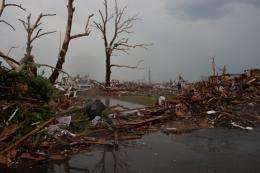An emergency network for natural disasters

Engineering researchers at the University of Arkansas are developing an emergency communications network that will maintain operation during natural disasters and provide critical warnings and geographic information to people affected by the disasters. The researchers are honing and testing the system now and expect to deploy a pilot network at the end of 2012.
The system, which the researchers call an emergency “mesh,” is self-sustainable and solar-powered, which means it would provide continuous, uninterrupted service even when the power grid or wireless communication systems are out of commission. Users would receive critical information on popular devices such as mobile phones, personal digital assistants, tablets and laptops.
“The ultimate goal of this project is to save human lives,” said Nilanjan Banerjee, assistant professor of computer science and computer engineering. “Deployment of this system could warn people to get out of harm’s way and could help emergency services personnel reach victims much faster. This last part is critically important because we know that many deaths occur in the minutes and hours after a disaster strikes.
“It is also important that the system communicates using popular, ubiquitous devices, because during these chaotic and highly stressful moments, people need to rely on something that is user-friendly and already familiar to them.”
The mesh can be thought of as a network of nodes that blanket a geographic area. Similar to servers, each solar-powered node contains data – geographic information – that can be downloaded to a user or communicated node-to-node, if necessary. The latter function is critically important in the event that a node or nodes fail due either to variability inherent in renewable energy or the likelihood of extreme environmental conditions in the aftermath of a natural disaster. If either or both happen, the mesh will automatically redistribute data to maintain service.
The geographic information will include a map, similar to the Google map service, that shows areas heavily affected by a disaster as well as routes around these areas. The system’s online demonstration displays a disaster area in red, while a green line shows an unobstructed or optimal route to an aid station or hospital.
Banerjee said several issues must be resolved before a practical and fully functioning system can be deployed. For sustainable operation on small solar panels, the nodes must operate on extremely low power yet still have enough power to send map-based information to users.
A hardware team led by Pat Parkerson, associate professor of computer science and computer engineering and co-principal investigator on the project, is developing and testing different hardware systems in an effort to strike this balance.
Also, a team led by Jack Cothren, associate professor of geosciences and director of the university’s Center for Advanced Spatial Technologies, is testing sophisticated GIS software that can function well on a device that has low power and limited resources. Another challenge is the geographical placement of nodes to ensure that optimal connectivity can be maintained regardless of topography.
To address all of these obstacles and test a combination of hardware and software, the researchers will deploy a 40-node mesh in downtown Fayetteville toward the end of 2012.
Banerjee said the technology could also apply to non-emergency scenarios, such as hiking in extreme wilderness areas or military operations in deserts or other remote locations.
The researchers received a $485,000 grant from the National Science Foundation to develop the system.
Provided by University of Arkansas


















